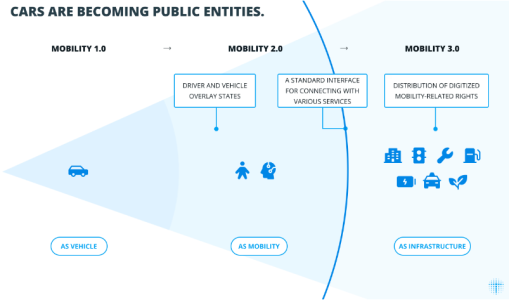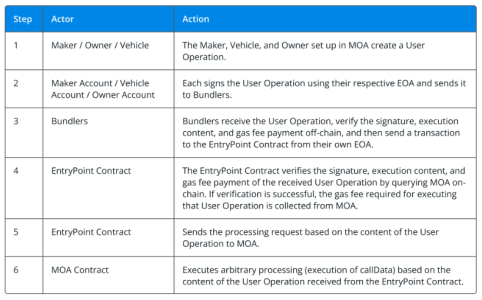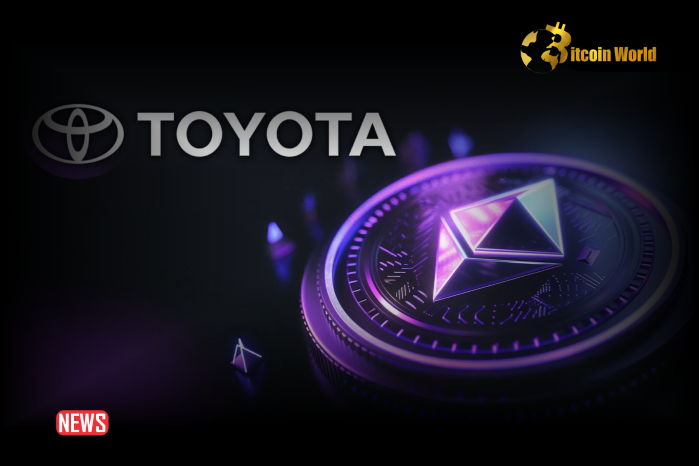Imagine a world where your car isn’t just a mode of transport, but a smart, secure, and programmable entity. Toyota is turning this vision into reality by leveraging the power of the Ethereum blockchain. Forget traditional car management; Toyota’s pioneering approach is setting the stage for a future where vehicles seamlessly integrate with our digital lives. Ready to dive in?
Toyota’s Bold Move: Ethereum-Powered Car Accounts
Toyota is taking a significant leap into the blockchain realm by creating digital accounts for cars on the Ethereum network. This isn’t just about tracking ownership; it’s about transforming cars into service-oriented entities, paving the way for fully autonomous driving and enhanced vehicle management.
- Enhanced Security: Blockchain’s inherent security features protect car data and transactions.
- Programmability: Cars become more adaptable and responsive to user needs and environmental changes.
- Seamless Integration: Connecting cars to services and users becomes streamlined and efficient.
This initiative is a core component of Toyota’s Mobility 3.0 concept, which aims to deeply integrate vehicles with public infrastructure. Toyota’s Blockchain Lab is at the forefront, exploring how blockchain can manage cars as digital accounts, making them more programmable and secure.

What is Mobility-Oriented Account (MOA)?
Toyota is implementing what they call Mobility-Oriented Accounts (MOA), using the Ethereum ERC-4337 standard. This approach transforms cars into service entities, ready for the era of autonomous driving.
The Motivation Behind Toyota’s Blockchain Move
Launched in April 2023, Toyota’s Mobility 3.0 concept envisions a future where cars interact dynamically with their environment, including traffic lights, other vehicles, and pedestrians. The goal is to evolve cars from mere personal property to semi-public entities. Blockchain facilitates this by enabling transparent and efficient information sharing.
Think of it this way: just as we recognize a car by its physical attributes and driving behavior, the digital representation involves overlaying states of both the driver and the vehicle. Representing these states on a blockchain allows each car to function as a unique account.

With MOA, every car, including the one right in front of you, can have its own account, seamlessly linking to users and other systems. Toyota believes this is crucial for making driverless cars a practical reality, enabling them to operate independently without human intervention.
How MOA Works: A Technical Deep Dive

Creating a blockchain account for a car traditionally involves storing a private key within the vehicle, which presents significant security risks. If the private key is compromised, the account is lost. Moreover, these accounts have limited functionality, requiring additional contracts to manage car information, adding complexity.
Toyota addresses these challenges by leveraging ERC-4337. This standard separates authentication from key management, ensuring account security even if the private key is lost. It allows for safer and more flexible account management.
By holding states that can be accessed externally, it’s possible to manage car information—such as usage history and maintenance records—transparently and efficiently.
MOA also enables multi-entity approval for operations. Car users, owners, manufacturers, dealers, and government agencies can all participate in the approval process for car transactions, enhancing security and accountability.
A key feature of ERC-4337 is the CREATE2 opcode, which allows addresses to be set before the account is deployed. This bridges existing vehicle ID systems with on-chain addresses, streamlining the entire process.
Benefits of Toyota’s Ethereum Integration
- Enhanced Security: Protecting vehicle data and transactions using blockchain technology.
- Increased Transparency: Providing clear and accessible records of car usage and maintenance.
- Improved Efficiency: Streamlining interactions between cars, users, and infrastructure.
- Autonomous Driving Ready: Paving the way for fully autonomous vehicles with secure and reliable digital identities.
Potential Challenges
- Scalability: Ensuring the blockchain network can handle a large number of car accounts.
- Regulation: Navigating the evolving regulatory landscape for blockchain and autonomous vehicles.
- User Adoption: Encouraging widespread adoption of blockchain-based car accounts.
Conclusion: The Road Ahead
Toyota’s innovative use of the Ethereum blockchain to create digital car accounts marks a significant step towards the future of mobility. By transforming cars into programmable, secure, and service-oriented entities, Toyota is not only enhancing vehicle management but also paving the way for a world where autonomous driving is a seamless and secure reality. As Toyota continues to refine and expand its Mobility 3.0 concept, the potential for blockchain to revolutionize the automotive industry becomes increasingly clear. The journey has just begun, and the road ahead is filled with exciting possibilities.
Disclaimer: The information provided is not trading advice, Bitcoinworld.co.in holds no liability for any investments made based on the information provided on this page. We strongly recommend independent research and/or consultation with a qualified professional before making any investment decisions.


